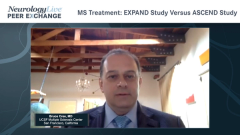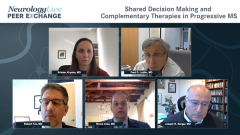
Age Considerations: Patients With Nonactive MS Progression
Considerations regarding age in treatment decisions in patients with nonactive multiple sclerosis progression.
Episodes in this series

Bruce Cree, MD: I’m going to come back to this point, because I think it’s an important one. A lot of our patients who are on these platform therapies don’t have evidence of disease activity. The platform therapies, even teriflunomide, are very effective at suppressing MRI lesions, so you may not see a new lesion. But the patients can still progress.
Let’s say you’ve got a younger patient, somewhere between the ages of 50 and 55, and they’re worsening despite treatment with the platform. What do you do then? It sounds like you’re a bit more conservative with those patients, Bob. Are there other opinions out there?
Joseph R. Berger, MD: Firstly, if I see disease activity, regardless of whether the patient has progressive disease or not, I’m going to switch their medication. That’s another story altogether.
The real question is: if the patient is progressing in the absence of any disease activity that’s apparent clinically other than their progression, or radiographically, what do you do with them? I have switched them. I don’t know whether it’s the right thing to do, because as Bob mentioned, we don’t have the data to support that. But I would give them the opportunity that wouldn’t exist if you didn’t switch them to a medication in which there has been some positive data generated that there’s an effect on progression. I will switch them to one of the drugs that has been demonstrated to have some effect on progression. I usually switch them to an anti-CD20, but I would switch them.
Bruce Cree, MD: Fred, any opinion here?
Fred D. Lublin, MD: I sort of agree. I would try either one, especially in someone who wasn’t old. That’s the group where I’m most likely to get a benefit. I’ll give them a year. I like to monitor for people for a year on one of these. At the end of the year, I can get an idea of whether we’re having an effect on their progression, of course, understanding that progression can settle down on its own.
The big concern in people who are on any of the therapies and doing well, but are slowly progressing, is: if you took away that therapy, would they progress more? That’s also one of the things we think about as part of the conversation, saying, “You’re no longer doing them any good. Stop the therapy altogether.” But there are a number of unknowns in doing that. Sometimes we’ll do it, especially in an older group. I have a much lower threshold for stopping therapy with older age groups. There is some work out of the Mayo Clinic that suggested that if you’re not progressing after the age of 75, you’re never going to progress.
Joseph R. Berger, MD: It’s a rather curious thing I find in our conversation today, Fred and I are talking about 75- and 80-year-olds while Bruce and Bob are talking about 50- and 55-year-olds. To me, old is like they’ve got to be older than I am.
Bruce Cree, MD: It’s all relative. There is something that is going on with age and MS [multiple sclerosis]. There’s clearly an interaction there. We know that contrast enhancement and lesions—we see these macroscopic lesions present on MRI—occur early on in the course of the disease and taper off gradually over time. We know that phenomena is an age-dependent process that we don’t exactly understand. Does it have to do with immunosenescence? Does it have to do with compensatory responses? Does it have to do with exhaustion of target tissue and loss of myelin? There are lots of possible explanations that we just don’t have a good handle on.
Nonetheless, there is this waning effect in terms of age: withering away relapsing activity, relapses decrease in frequency with age, and withering away inflammatory disease activity measured by these macroscopic lesions present on MRI. Age being a major driver for progressive disease and worsening disability is almost as if the MS brain is aging in an accelerating way.
Fred D. Lublin, MD: Immunosenescence is just plain offensive. Joe will agree with that. In fact, earlier today, Benjamin Segal, MD, gave a keynote address at the ACTRIMS [Americas Committee for Treatment and Research in Multiple Sclerosis] Forum. He talked about some of the changes occurring in aging. Immunosenescence is probably an incorrect concept. There are changes, and some of those changes are actually making immune function worse and more toxic in certain ways. This is something that future research will help us with. There are changes with age, obviously, mostly for the better. Nevertheless, there are changes toward a more toxic environment.
Robert Fox, MD: In the very young patients, I will be completely flipped. In the patient who’s in their 20s or 30s with progressive MS, I will take the approach of knowing their risks of complications from these therapies are much lower, and they can’t afford to have another lesion inflicted on their spinal cord. I want to be even more aggressive with my anti-inflammatory therapies to prevent new lesions because they were already struggling at a very young age, and the risks are probably going to be a fair bit lower. I will flip my argument on its head in the very young patients and become more aggressive, even in the absence of evidence of active inflammation.
Bruce Cree, MD: Kristen, do you have any comments on this very controversial topic about what to do with patients who don’t have active disease? What do you do with these nonactive progressive patients?
Kristen Krysko, MD: Yes, I have a similar approach. Age is a big factor, as well as level of disability. I’ve seen some bad outcomes in patients who were wheelchair-bound being treated with strong immunosuppressive agents. I tend to steer away from that more. But if someone’s younger, in their 50s, and actively worsening, those are the patients I would tend to treat even without inflammatory activity.
In Canada, we’re a bit limited sometimes because SPMS [secondary progressive multiple sclerosis] with activity is the only indication for siponimod. We cannot give it if there’s no documented activity. Sometimes the regulatory rules and coverage do impact that. Similarly, we can’t get ocrelizumab covered if we label someone as having secondary progressive MS. We would have to call them relapsing MS. For instance, having a relapse within the last 2 years is required.
Bruce Cree, MD: It’s interesting how these things all shake out in different health care environments.
Thank you for watching NeurologyLive® Peer Exchange. If you enjoyed the content, please subscribe to our e-newsletters to receive upcoming Peer Exchanges and other great content right in your inbox.
Transcript Edited for Clarity
Newsletter
Keep your finger on the pulse of neurology—subscribe to NeurologyLive for expert interviews, new data, and breakthrough treatment updates.



































